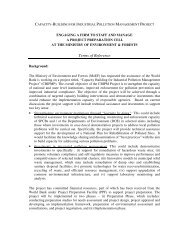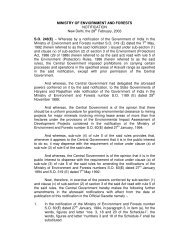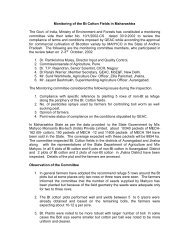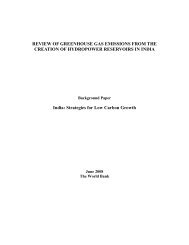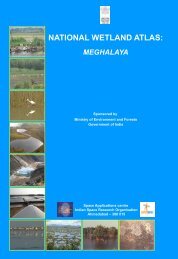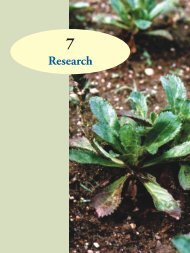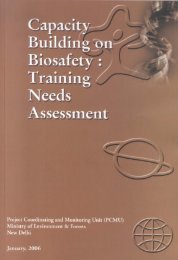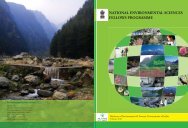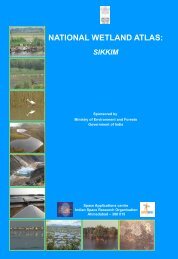Securing the Future for Elephants in India - Ministry of Environment ...
Securing the Future for Elephants in India - Ministry of Environment ...
Securing the Future for Elephants in India - Ministry of Environment ...
Create successful ePaper yourself
Turn your PDF publications into a flip-book with our unique Google optimized e-Paper software.
(0.0097) from s<strong>in</strong>gle source study conducted at Anamalai or Mudumalai<br />
cannot be applied <strong>for</strong> <strong>the</strong> whole country. Guidel<strong>in</strong>es to ei<strong>the</strong>r generate<br />
reliable defecation rate data or compilations <strong>of</strong> prior data from wild<br />
elephants have been scarce. In conclusion, <strong>the</strong> method <strong>of</strong> dung data<br />
collection <strong>for</strong> convert<strong>in</strong>g dung density estimates <strong>in</strong>to elephant numbers<br />
over large landscape has a very large potential <strong>for</strong> error and biases and<br />
hence is not a reliable approach. It is also limited <strong>in</strong> scope and has limited<br />
ability to detect changes through short-term time-series monitor<strong>in</strong>g.<br />
Currently Project Elephant coord<strong>in</strong>ates a countrywide elephant census<br />
once <strong>in</strong> five years and from 2005 each reserve conducts its own estimation.<br />
Estimation, Research and Monitor<strong>in</strong>g: Recommendations<br />
1. Establish National Elephant Basel<strong>in</strong>es and estimation protocols by a<br />
Consortium <strong>of</strong> Elephant Research and Estimation (CERE) anchored by<br />
<strong>the</strong> National Elephant Conservation Authority<br />
A properly designed elephant monitor<strong>in</strong>g program based on reliable and<br />
robust methods has much wider applicability <strong>for</strong> detect<strong>in</strong>g changes <strong>in</strong><br />
elephant population status and trends over time and space. This should be<br />
coord<strong>in</strong>ated by a Consortium <strong>of</strong> Elephant Research and Estimation<br />
(CERE).<br />
This is recommended to be a consortium <strong>of</strong> people and organizations with<br />
<strong>the</strong> requisite scientific skills and capabilities. Important among <strong>the</strong>m are<br />
scientists (<strong>in</strong>clud<strong>in</strong>g <strong>in</strong>dividuals <strong>of</strong> scientific em<strong>in</strong>ence who are<br />
<strong>in</strong>dependent research scholars), statisticians, government research<br />
<strong>in</strong>stitutions, universities, and non- government organizations engaged <strong>in</strong><br />
scientific research and conservation. There should be regional nodal<br />
scientific agencies identified to coord<strong>in</strong>ate monitor<strong>in</strong>g and estimation <strong>of</strong><br />
elephants at <strong>the</strong> regional level. The CERE which will be nestled with<strong>in</strong> <strong>the</strong><br />
NECA will facilitate and coord<strong>in</strong>ate <strong>the</strong> work<strong>in</strong>g <strong>of</strong> <strong>the</strong> regional nodal<br />
agencies.<br />
33




